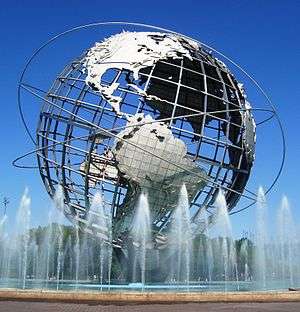Richmond Hill, Queens
| Richmond Hill | |
|---|---|
| Neighborhoods of Queens | |
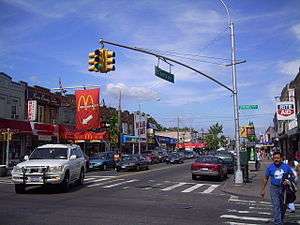 Liberty Avenue intersecting with Lefferts Boulevard in Richmond Hill. | |
|
Location within New York City | |
| Country |
|
| State |
|
| City |
|
| County/Borough |
|
| Founded | 1868 |
| Named for | Edward Richmond |
| Population (2010)[1] | |
| • Total | 62,982 |
| Race/Ethnicity[2] | |
| • Hispanic | 36.0% |
| • Asian | 27.4 |
| • White | 11.2 |
| • Black | 11.1 |
| • Other | 14.4 |
| Economics | |
| ZIP codes | 11418, 11419 |
| Area code(s) | 718, 347, 929, and 917 |
Richmond Hill is a commercial and residential neighborhood located in the southwestern section of the borough of Queens, in New York City, New York, United States. The neighborhood is split between Queens Community Board 9 and 10.[3] The area borders Kew Gardens and Forest Park to the north, Jamaica and South Jamaica to the east, South Ozone Park to the south, and Woodhaven and Ozone Park to the west.
Richmond Hill is known as Little Guyana-Trinidad and Tobago, for its large Indo-Guyanese, Indo-Trinidadian and Tobagonian, and Indo-Caribbean immigrant population, as well as Little Punjab, for its large Punjabi immigrant population.[4] Richmond Hill is home to a density of Roman Catholic, Eastern Orthodox, Christian, Sikh, Hindu, Jewish, and Muslim places of worship.
Main commercial streets in the neighborhood include Jamaica Avenue, Atlantic Avenue and Liberty Avenue. The portion of the neighborhood south of Atlantic Avenue is also known as South Richmond Hill. The Long Island Rail Road provides freight access via the Montauk Branch, which runs diagonally through the neighborhood from northwest to southeast. The ZIP codes are 11418 for the main portion of Richmond Hill and 11419 for South Richmond Hill. Many residents own homes, though some also rent within small apartment buildings.
Location
Richmond Hill is located between Kew Gardens and Forest Park to the north, Jamaica and South Jamaica to the east, South Ozone Park to the south, and Woodhaven and Ozone Park to the west. Hillside Avenue forms its northern boundary with Kew Gardens east of Lefferts Boulevard, while Forest Park and the right-of-way of the Long Island Rail Road (LIRR)'s Montauk Branch form its northern edge west of Lefferts. Its western boundary north of Atlantic Avenue is formed by the LIRR's abandoned Rockaway Beach Branch; south of Atlantic, the western border lies between 104th and 107th Streets. The southern border extends to around 103rd Avenue or Liberty Avenue. The Van Wyck Expressway abuts the eastern end of the community.[5][6][7][8] The portion of the neighborhood south of Atlantic Avenue is also known as South Richmond Hill.[4]
History
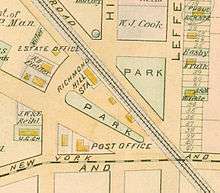
The hill referred to as Richmond Hill is a moraine created by debris and rocks collected while glaciers advanced down North America during the Wisconsin glaciation.[9][10] Prior to European colonization, the land was occupied by the Rockaway Native American group, for which the Rockaways were named.[11][12][13][14][15] In 1660, the Welling family purchased land in what was then the western portion of the colonial town of Rustdorp. The land would become the Welling Farm, while Rustdorp would be renamed Jamaica under British rule in 1664.[16] The Battle of Long Island, one of the bloodiest battles of the Revolutionary War, was fought in 1776 along the ridge in present-day Forest Park, near what is now the golf course clubhouse. Protected by its thickly wooded area, American riflemen used guerrilla warfare tactics to attack and defeat the advancing Hessians.[17][18] One of the sites that would make up modern Richmond Hill, Lefferts Farm, was said to be the site of a Revolutionary War battle.[11] In January 1853, a Farming community was established on the south side of Jamaica Avenue between 110th and 112th Streets, known as Clarenceville. This land was purchased from the Welling estate.[16][19][20]
Richmond Hill's name was inspired either by a suburban town near London or by Edward Richmond, a landscape architect in the mid-19th century who designed much of the neighborhood.[9][21] In 1868, Albon Platt Man, a successful Manhattan lawyer, purchased the Lefferts, Welling, and Bergen farms along with other plots amounting to 400 acres of land, and hired Richmond to lay out the community. The tract extended as far north as White Pot Road (now Kew Gardens Road) near modern Queens Boulevard.[9][11][12][19][20][22][23] The area reminded Man of the London suburb, where his family resided.[24] Man's sons would later found the nearby Kew Gardens neighborhood from the northern portion of the land.[19][20][25][21]
Streets, schools, a church, and a railroad were built in Richmond Hill over the next decade, thus making the area one of the earliest residential communities on Long Island. The streets were laid down to match the geography of the area.[9][19][23] The development of area was facilitated by the opening of two railroad stations. These were the Clarenceville station on the Brooklyn and Jamaica Railroad, at Atlantic Avenue and Greenwood Avenue (now 111th Street); and the Richmond Hill station at Park Street (now Hillside Avenue) near Jamaica and Lefferts Avenues on the Montauk railroad line between Long Island City and eastern Long Island.[16][26] By 1872, a post office was established in the neighborhood,[11][27][28] while the Clarenceville neighborhood was merged into Richmond Hill.[19] Richmond Hill was incorporated as an independent village in 1894, by which time it had also absorbed the Morris Park neighborhood, which had been established in 1885.[19][20][29] In 1898, Richmond Hill and the rest of Queens county were consolidated into the City of Greater New York.[19][29]
The New York City Subway's BMT Fulton Street Line was extended east along Liberty Avenue into the area on September 25, 1915, terminating at Lefferts Avenue (now Lefferts Boulevard). It is now the southern terminal of the A train.[30] The area received further development when the BMT Jamaica Line elevated, now served by the New York City Subway's J and Z trains, was extended east into the neighborhood at Greenwood Avenue (now 111th Street) on May 28, 1917.[19][31] As the neighborhood's population continued to grow into the 1920s, smaller closely spaced houses and apartment buildings began to replace large private houses.[19][29]
Housing
The area is well known for its large-frame single-family houses, many of which have been preserved since the turn of the 20th century. Many of the Queen Anne Victorian homes of old Richmond Hill still stand in the area today.[4][5]
Landmarks
The Triangle Hofbrau, opened as a hotel in 1893 and as a restaurant in 1893, was a restaurant which was frequented by such stars as Mae West in the 1920s and 1930s. It sat on the triangular piece of land bordered by Hillside Avenue, Jamaica Avenue, and Myrtle Avenue.[19][25][32][33][34] The building has since been converted to medical offices.[32][35] Near the northwest corner of Hillside Avenue and Myrtle Avenue sat an old time ice cream parlor, Jahn's. It closed in late 2007.[32] Between Myrtle Avenue and the Montauk Line railroad is a former movie theatre, RKO Keith's Richmond Hill Theater, opened in 1929, functioning since 1968 as a bingo hall.[35][36][37] These and several other landmarks are located in the vicinity of the "Richmond Hill Triangle", bracketed by Jamaica Avenue, Myrtle Avenue, and 117th Street. This was historically the commercial center of Richmond Hill.[19][27][28][33][36][38] The intersection of Jamaica and Myrtle Avenues is also known as James J. Creegan Square.[33][39]
The northern edge of Richmond Hill contains the Church of the Resurrection. This Episcopalian church is an 1874 structure and is the oldest house of worship in Richmond Hill.[25] It was placed in the National Register of Historic Places in 2003.[40] Also listed on the National Register of Historic Places are Public School 66 and Saint Benedict Joseph Labre Parish.[41]
Demographics
Originally, many European families (Italian, Dutch, British, Irish, Scots, Danish, and German) lived in Richmond Hill.[19][32] In the 1970s, the neighborhood was predominantly Hispanic.[12][19] Today, the south side of Richmond Hill consists mostly of South Asian Americans (Indians, Pakistanis, and Bangladeshis) and Indo-Caribbean Americans (Trinidadians, Guyanese, Surinamese, and Jamaicans), who have steadily emigrated to the United States since the 1960s.[19][42] Richmond Hill also has the largest Sikh population in the city.[32][6]
Based on data from the 2010 United States Census, the population of Richmond Hill was 62,982, a decrease of 3 (0.0%) from the 62,985 counted in 2000. Covering an area of 1,171.55 acres (474.11 ha), the neighborhood had a population density of 53.8 inhabitants per acre (34,400/sq mi; 13,300/km2).[1]
The racial makeup of the neighborhood was 11.2% (7,078) White, 11.1% (6,960) African American, 1.0% (657) Native American, 27.4% (17,252) Asian, 0.2% (116) Pacific Islander, 6.6% (4,139) from other races, and 6.6% (4,136) from two or more races. Hispanic or Latino of any race were 36.0% (22,644) of the population.[4][2]
Media
WICR, 1620AM, broadcasts Indo-Caribbean programming from studios on Liberty Avenue in South Richmond Hill.
Parks and recreation
- Forest Park, located at the north edge of the neighborhood.[10][19]
- Jacob Riis Triangle
- Lt. Frank McConnell Memorial Park
- Phil "Scooter" Rizzuto Park, formerly Smokey Oval Park, at Atlantic Avenue between 125th and 127th Street. The name "Smokey Oval" referred to the smoke from the adjacent Morris Park Facility of the Long Island Rail Road. In June 2008 was named after New York Yankees player and broadcaster Phil Rizzuto, who played baseball at nearby Richmond Hill High School.[9][43][44][45][46]
Education
Libraries
Schools
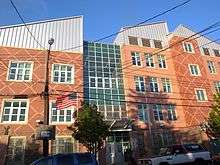
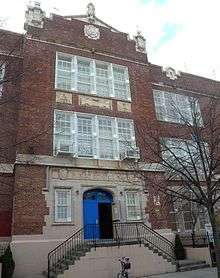
Richmond Hill schools are operated by the New York City Department of Education.
Public elementary schools include:
- P.S. 51
- P.S. 161 Arthur R. Ashe Junior School
- P.S. 54 Hillside Avenue School
- P.S. 55 The Maure School
- P.S. 56 Harry Eichler School
- P.S. 62 Chester Park School
- P.S. 66 Jacqueline Kennedy Onassis School, a New York City Landmark.[47]
- P.S. 90 Horace Mann School
Residents are zoned to MS 72, MS 217 in Briarwood, and MS 137 in Ozone Park. Students also attend other middle schools and high schools in the city.
Richmond Hill High School is located in the neighborhood. Until June 2012, the city had planned to close the high school. The city had slated the school to close; however, a court ruling prevented the school's closure.[48][49]
Richmond Hill High School is the zoned school for Richmond Hill Residents, while some living towards the east of Richmond Hill has Hillcrest High School as their zoned school.
Private schools include:
- Bethlehem Christian Academy
- Hebrew Academy-West Queens
- Holy Child Jesus Academy Holy Child Jesus School
- Islamic Elementary School
- Theatre Street School
Transportation
Richmond Hill is served by several New York City Subway stations.[5] The J and Z trains stops at 121st Street and Jamaica Avenue, and the J train stops at 111th Street and Jamaica Avenue. The Jamaica–Van Wyck station on the E train, and the 111th Street and Ozone Park–Lefferts Boulevard stations on the A train, are also located in Richmond Hill.[50]
There was a Long Island Rail Road station named Richmond Hill on Hillside Avenue and Babbage Street along the Montauk Branch. However, this station was closed in 1998 due to low ridership (this station had just one daily rider at the time of its closure).[51] The station and platform remain, though access via the staircase at Jamaica Avenue is gated off.[52][33] Today the Kew Gardens and Jamaica stations serve the area.[53]
The area is also served by MTA Regional Bus Operations routes.[5] These include the Q8, Q9, Q10, Q24, Q37, Q41, Q55, Q56 and Q112 local buses, as well as the QM18 express bus to Manhattan.[53]
Notable residents
- Stella Asling-Riis (1869-1957), Canadian-born novelist and clubwoman based in Richmond Hill
- Amelia Edith Huddleston Barr (1831-1919), author of the book Jan Vedder's Wife and an advocate of women's rights.[54]
- Gary Barnett (born c. 1956), President and founder of Extell Development Company.[55]
- Jack Cassidy (1927-1976), Broadway and television actor was born and raised in Richmond Hill.[56]
- Percy Crosby (1891-1964), creator of the comic Skippy.[57]
- Rodney Dangerfield (1921-2004), comedian who attended Richmond Hill High School.
- Danny Fields (born 1939), music manager, publicist, journalist and author, who was an influential figure in the punk rock world.[58]x, drugs, rock ’n’ roll and its subject’s self-deprecating humor."
- Morton Gould (1913-1996), composer, conductor, arranger, and pianist. who won a Pulitzer Prize, Kennedy Center Honor and a Grammy Award.[59]
- Alfred H. Grebe (1895-1935), pioneer in radio broadcasting.[60]
- Seymour Halpern (1913-1997), politician who represented Queens in the United States House of Representatives from 1959 to 1973.[61]
- William Hickey (1927-1997), actor and voice actor best known for his Academy Award-nominated role as Don Corrado Prizzi in the John Huston film Prizzi's Honor.[62]
- Frank Kameny (1925-2011), LGBT rights activist.[63]
- Jack Kerouac (1922-1969), novelist and poet who lived in Richmond Hill from 1950 to 1955.[44][64]
- Wilbur Knorr (1945-1997), historian of mathematics and a professor in the departments of philosophy and classics at Stanford University.[65]
- Jack Lord (1920-1998), actor best known for portraying Lt. Steve McGarrett on Hawaii Five-O.[66]
- Jack Maple (1952-2001), former deputy commissioner of New York City Police Department and architect of the CompStat system that inspired the television series The District.[67]
- Marx Brothers – Family comedy act, whose house is still noted with a commemorating plaque.[9]
- John H. Myers (born 1945), former CEO of GE Asset Management (childhood residence).
- Anaïs Nin (1923-1977), French-Cuban author of The Delta of Venus and diarist, who lived in Richmond Hill prior to moving to Paris in 1924.[68]
- Helen Palsgraf, plaintiff in landmark tort case Palsgraf v. Long Island Railroad Co.
- Jacob Riis(1849-1914), documentary journalist/author, photographer and reformer was a Richmond Hill resident.[9]
- Phil Rizzuto(1917-2007), Hall of Fame Baseball Player who lived and went to high school in Richmond Hill. Phil "Scooter" Rizzuto Park in the neighborhood is named after him.[5][9][43][44]
- Bob Sheppard (1910–2010), public address announcer for the New York Yankees and New York Giants.[5][69]
- Robin Tewes (born 1950), New York City-based painter, born and raised in Richmond Hill.
- Dick Van Patten (1928-2015), actor, raised in Richmond Hill.[70]
References
- 1 2 Table PL-P5 NTA: Total Population and Persons Per Acre - New York City Neighborhood Tabulation Areas*, 2010, Population Division - New York City Department of City Planning, February 2012. Accessed June 16, 2016.
- 1 2 Table PL-P3A NTA: Total Population by Mutually Exclusive Race and Hispanic Origin - New York City Neighborhood Tabulation Areas*, 2010, Population Division - New York City Department of City Planning, March 29, 2011. Accessed June 14, 2016.
- ↑ Queens Community Boards, New York City. Accessed September 3, 2007.
- 1 2 3 4 Haller, Vera (January 11, 2013). "Living In Richmond Hill: Indo-Caribbean Content, Victorian Style". The New York Times. Retrieved August 24, 2016.
- 1 2 3 4 5 6 Fraser, Lisa (January 1, 2014). "City Living: Richmond Hill has gorgeous homes and lots of culture". Newsday. Retrieved August 23, 2016.
- 1 2 "South Richmond Hill Neighborhood Profile (2011)" (PDF). Queens Economic Development Corporation. 2011.
- ↑ "NYC Census FactFinder". nyc.gov.
- ↑ "Community Portal: Queens Community District 9". New York City Department of City Planning.
- 1 2 3 4 5 6 7 8 "Phil "Scooter" Rizzuto Park; Smokey Oval: History". New York City Department of Parks and Recreation. Retrieved August 23, 2016.
- 1 2 "Forest Park: History". New York City Department of Parks and Recreation.
- 1 2 3 4 Orman, John (October 27, 1972). "Historical Notes on Richmond Hill". Leader-Observer. Fultonhistory.com. Retrieved August 21, 2016.
- 1 2 3 Bode, Nicole (August 25, 2002). "RICHMOND HILL'S DIVERSE FACE Pride in multiculturalism". New York Daily News. Retrieved August 21, 2016.
- ↑ "American Indians of Long Island, NY". The Richmond Hill Historical Society. Retrieved August 21, 2016.
- ↑ Antos, Jason D. (August 10, 2011). "Native Americans Gather For Annual City Powwow". Queens Gazette. Retrieved August 21, 2016.
- ↑ Tarek, Shams (July 25, 2003). "Native Queens: Large Community, Scattered Lives". Southeast Queens Press. Retrieved August 21, 2016.
- 1 2 3 "DANIEL AND ABBIE B. ELDRIDGE HOUSE" (PDF). New York City Landmarks Preservation Commission. Retrieved August 23, 2016.
- ↑ "Forest Park Is December's Park Of The Month". The Daily Plant. December 27, 2007. Retrieved August 23, 2016.
- ↑ Dallas, Gus. "Battle of Long Island: Hard Times followed Battle of Long Island". The Richmond Hill Record, Richmond Hill Historical Society. Retrieved August 23, 2016.
- 1 2 3 4 5 6 7 8 9 10 11 12 13 14 15 Kenneth T. Jackson; Lisa Keller; Nancy Flood (December 1, 2010). The Encyclopedia of New York City: Second Edition. Yale University Press. p. 5716. ISBN 978-0-300-18257-6.
- 1 2 3 4 Carl Ballenas (2011). Jamaica. Arcadia Publishing. pp. 102, 105. ISBN 978-0-7385-7426-4. Retrieved August 21, 2016.
- 1 2 Boone, Ruschell (May 7, 2015). "Names of Richmond Hill, Kew Gardens Have Roots in England". NY1. Retrieved August 21, 2016.
- ↑ The Richmond Hill Chapter of The Queens Historical Society. "Victorian Richmond Hill". Retrieved December 16, 2014.
- 1 2 Shaman, Diana (April 3, 1977). "What Is Hard Porn Doing In a Nice Place Like This?" (PDF). The New York Times. Retrieved August 23, 2016.
- ↑ Carl Ballenas with the Aquinas Honor Society of the Immaculate Conception School (February 24, 2014). Images of America: Kew Gardens. Arcadia Publishing. ISBN 978-1-4671-2072-2. Retrieved August 23, 2016.
- 1 2 3 Carl Ballenas; Nancy Cataldi (2002). Images of America: Richmond Hill. Arcadia Publishing. ISBN 978-0-7385-1031-6. Retrieved August 21, 2016.
- ↑ David D. Morrison; Valerie Pakaluk (2003). Long Island Rail Road Stations. Arcadia Publishing. pp. 40–41. ISBN 978-0-7385-1180-1.
- 1 2 "Richmond Hill To Celebrate 105th Anniversary". Leader-Observer. Fultonhistory.com. October 20, 1977. p. 1. Retrieved August 21, 2016.
- 1 2 Marzlock, Ron (February 27, 2014). "Richmond Hill's many post offices". Queens Chronicle. Retrieved August 21, 2016.
- 1 2 3 "RICHMOND HILL REPUBLICAN CLUB" (PDF). nyc.gov. New York City Landmarks Preservation Commission. December 17, 2002. Retrieved August 21, 2016.
- ↑ "New Elevated Line Opened for Queens" (PDF). The New York Times. September 26, 1915. Retrieved September 28, 2007.
- ↑
- "To Open Jamaica Av. Line.; Nearly Two and a Half Miles Ready for Operation Tonight" (May 27, 1917). New York Times Company. May 27, 1917. p. 24. Retrieved April 21, 2015.
- "Jamaica Avenue 'L' is an Old Story Already" (PDF) (May 31, 1917). Leader Observer (Queens/Brooklyn, NY). May 31, 1917. p. 1. Retrieved April 20, 2015.
- Report of the Public Service Commission for the First District of the State of New York, Volume 1. New York State Public Service Commission. January 15, 1918. pp. 73, 81, 312–314. Retrieved April 20, 2015.
- 1 2 3 4 5 Mokha, Kavita (August 20, 2010). "New Immigrants Put Stamp on Richmond Hill". Wall Street Journal. Retrieved August 21, 2016.
- 1 2 3 4 Walsh, Kevin (March 7, 2010). "MYRTLE AVENUE Part 4, Glendale, Forest Park, Richmond Hill". Forgotten New York. Retrieved August 21, 2016.
- ↑ Doyle, Dennis. "Photos of the Triangle Hofbrau- Richmond Hill Historical Society". www.richmondhillhistory.org. Retrieved January 7, 2018.
- 1 2 Marin, Matthew (July 5, 2001). "Owner Of Old Movie Theater In Richmond Hill Fixes Marquee". Queens Chronicle. Retrieved August 21, 2016.
- 1 2 Gross, Jane (April 6, 1985). "Change And Constancy At The Heart Of Richmond Hill". The New York Times. Retrieved August 21, 2016.
- ↑ "RKO Keith's Richmond Hill in Richmond Hill, NY - Cinema Treasures". cinematreasures.org. Retrieved January 7, 2018.
- ↑ Davidson, Alex (January 16, 2003). "Richmond Hill LIRR site to get $75,000 overhaul". Times Ledger. Retrieved August 21, 2016.
- ↑ "James J. Creegan Square, Queens" (PDF). La Guardia and Wagner Archives. The City of New York. 1989. Retrieved August 21, 2016.
- ↑ Richmond Hill Historical Society, "About the Church of the Resurrection: First Church erected in Richmond Hill." http://www.richmondhillhistory.org/Resurrection.shtml
- ↑ National Park Service (2010-07-09). "National Register Information System". National Register of Historic Places. National Park Service.
- ↑ Semple, Kirk (June 8, 2013). "New York City's Newest Immigrant Enclaves;Take the A Train to Little Guyana; Sri Lankans have gathered on Staten Island, Arabs in Brooklyn, Ghanaians in the Bronx: A guide to the new immigrant enclaves of New York City". The New York Times.
- 1 2 Associated Press (June 27, 2008). "Queens park renamed for Phil Rizzuto". New York Daily News. Retrieved August 23, 2016.
- 1 2 3 Sullivan, John (October 1, 2007). "Sikhs Back Renaming of a Queens Park for Rizzuto". The New York Times. Retrieved August 23, 2016.
- ↑ Hirshon, Nicholas (September 25, 2007). "Holy cow! Phil Rizzuto may get park honor". New York Daily News. Retrieved August 23, 2016.
- ↑ "RICHMOND HILL PARK'S NAME HONORS SCOOTER". Times Newsweekly. July 3, 2008. Retrieved August 23, 2016.
- ↑ Gustafson, Anna (June 23, 2011). "Celebrating a school steeped in rich history: PS 66 in Richmond Hill is Queens' first school to be landmarked by city". Queens Chronicle. Retrieved August 24, 2016.
- ↑ "DOE will not close six Queens schools". Retrieved January 7, 2018.
- ↑ "New names selected for schools expected to close, reopen in the fall", New York Daily News.
- ↑ "Subway Map" (PDF). Metropolitan Transportation Authority. January 18, 2018. Retrieved January 18, 2018.
- ↑ Sengupta, Somini (March 15, 1998). "End of the Line for L.I.R.R.'s 10 Loneliest Stops". The New York Times. Retrieved August 7, 2009.
- ↑ Simon, David (January 30, 2003). "Rundown Rich. Hill LIRR Station To Receive $75,000 Overhaul". Queens Chronicle. Retrieved August 21, 2016.
- 1 2 "Queens Bus Map" (PDF). Metropolitan Transportation Authority. December 2017. Retrieved April 24, 2018.
- ↑ More About Amelia Edith Barr, Richmond Hill Historical Society. Accessed August 21, 2016.
- ↑ Leonard, Devin. "Gary Barnett, Controversial Master of New York City Luxury Real Estate; Gary Barnett is pretty down to earth for a guy whose new tower is 90 stories tall, warehouses money for oligarchs, and blots out the sun", Bloomberg.com, October 2, 2014. Accessed August 21, 2016. "Barnett lives in a two-story house in middle-class Richmond Hill, Queens, with his second wife, Ayala, who together have 10 children."
- ↑ About Jack Cassidy - Actor, Richmond Hill Historical Society. Accessed August 21, 2016. "Born March 5, 1927, John Edward Cassidy, better known as Jack, grew up in Richmond Hill, New York."
- ↑ Gardner, Jared. "Becoming Percy Crosby", The Comics Journal, October 3, 2012. Accessed August 21, 2016. "Given the tumultuous adulthood Percy Crosby would experience, it is not surprising that he would hang onto a romantic memory of his formative years in Richmond Hill. However, Richmond Hill was never quite the sleepy small town that would serve as the hazy, lazy background to Crosby's most famous and enduring creation, Skippy."
- ↑ Dollar, Steve. "A Life on the Edges of Fame; In a new documentary ‘Danny Says,’ a behind-the-scenes player talks sex, drugs and the punk era", The Wall Street Journal, September 28, 2016. Accessed August 28, 2016. "The Richmond Hill, Queens, native relates his colorful history, intimately aligned with the eruption of the 1960s counterculture and 1970s punk rock, in Danny Says, a new documentary that revels in se
- ↑ Holland, Bernard. "Morton Gould, Composer And Conductor, Dies at 82", The New York Times, February 12, 1996. Accessed October 25, 2017. "Morton Gould was born in the Richmond Hill section of Queens, N.Y., in 1913."
- ↑ "50 People To Know: Radio Pioneer Alfred H. Grebe", WCBS-AM, December 30, 2016. Accessed October 25, 2017. "Since this storytelling series is tied to our radio station’s 50th anniversary, we wanted to use our first installment to tell you about someone who could be considered the father of Newsradio 880. Meet Alfred H. Grebe, born in Richmond Hill, Queens in 1895."
- ↑ Thomas Jr., Robert McG. "Seymour Halpern, 83, Dies; Served Queens in Congress", The New York Times, January 11, 1997. Accessed October 25, 2017. "Mr. Halpern, who was born in Richmond Hill, was so indoctrinated with Republican politics as a youth that he seemed in a hurry to get into the fray."
- ↑ Van Gelder, Lawrence. "William Hickey, Actor, 69, Dies; Played a Wise Old Don in Prizzi", The New York Times, July 1, 1997. Accessed October 25, 2017. "Mr. Hickey, born in Brooklyn, said his upbringing in Flatbush and in Richmond Hill, Queens, in a close Irish family helped him to understand the family loyalty of the murderous Prizzis."
- ↑ Warekar, Tanay. "NYC Pride: 25 historic LGBTQ sites to visit; Check out these must-see LGBTQ landmarks in New York City during Pride Month", Curbed NY, June 29, 2018. accessed August 22, 2018. "One of the pioneers of the gay rights movement in the United States, Frank Kameny grew up in this house in Richmond, Queens, and attended the Richmond Hill High School, where he graduated from in 1941."
- ↑ Doyle, Dennis. "The Richmond Hill Historical Society". www.richmondhillhistory.org. Retrieved January 7, 2018.
- ↑ Saxon, Wolfgang. "Wilbur Knorr, 51, Mathematics Historian", The New York Times, March 31, 1997. Accessed October 25, 2017. "Dr. Knorr, a native of Richmond Hill, Queens, graduated summa cum laude from Harvard University, where he received a master's degree in 1968 and a doctorate in 1973."
- ↑ "Lord, Jack", American National Biography. Accessed October 25, 2017. "Lord, Jack (30 Dec. 1920-21 Jan. 1998), actor, was born John Joseph Patrick Ryan in Brooklyn, New York, the second of five children of William L. Ryan, a New York City policeman, and Ellen Ryan (née O'Brien). John grew up mostly in Richmond Hill, Queens, attending Saint Benedict Joseph Labre, a Roman Catholic primary school, and then John Adams High School, a public school."
- ↑ Martin, Douglas. "Jack Maple, 48, a Designer of City Crime Control Strategies", The New York Times, August 6, 2001. Accessed October 25, 2017. "John Edward Maple was born Sept. 23, 1952, and grew up in the Richmond Hill section of Queens."
- ↑ Dinnage, Rosemary. "Dearest Diary", The New York Times, September 5, 1982. Accessed August 22, 2018. "At the time these diaries were written, the family, financially somewhat harassed, had moved from the Continent to Richmond Hill in Queens, N.Y., there to be surrounded by a network of Spanish-speaking relatives. Two younger brothers are at school; Anais mends stockings, attends some courses at Columbia, pines for a succession of boys, starts a career as artist's model and, by 1923 when she is 20 years old, becomes engaged."
- ↑ Coffey, Wayne. "For nearly 60 years Bob Sheppard has set tone of Yankee Stadium", New York Daily News, September 20, 2008. Accessed June 15, 2016. "The son of a New York City building inspector, Sheppard was born in Ridgewood, Queens before the family moved to Richmond Hill."
- ↑ Rice, Kenny. "Van Patten's interest in racing is no act", ESPN, October 3, 2001. Accessed August 26, 2018. "Handicapping is no act for Dick Van Patten, who grew up during the Depression in the Richmond Hill section of New York near Aqueduct Race Track."
External links
| Wikimedia Commons has media related to Richmond Hill, Queens. |
Official government websites:
Historical societies:
